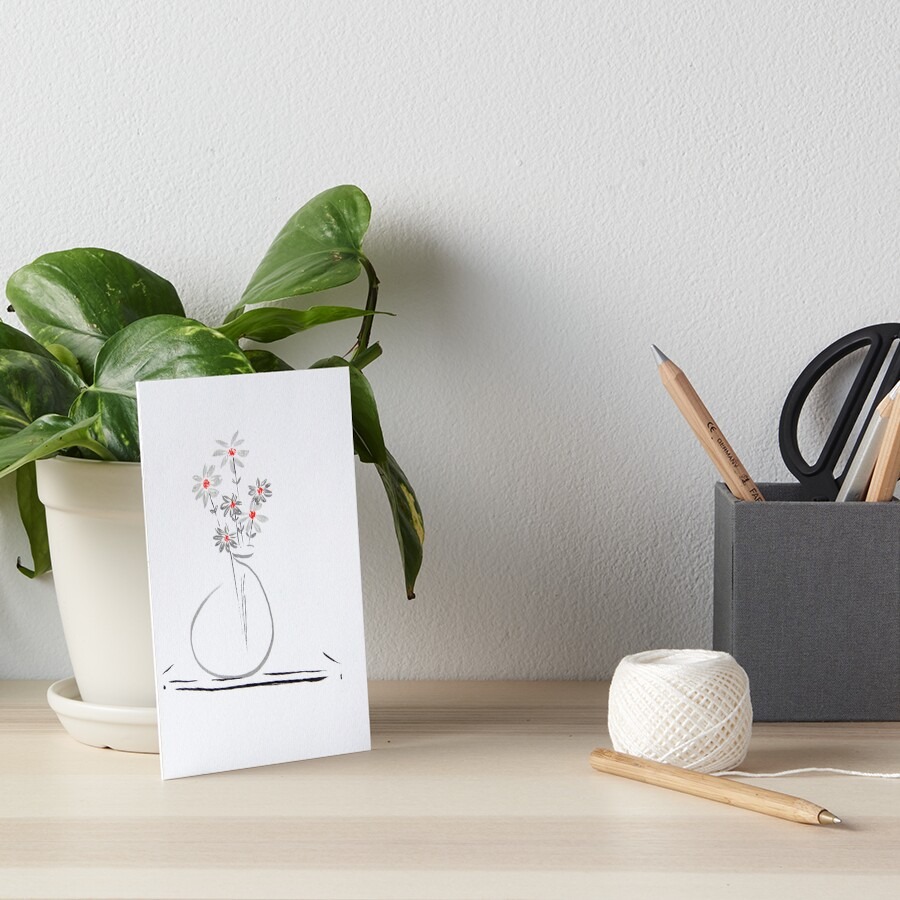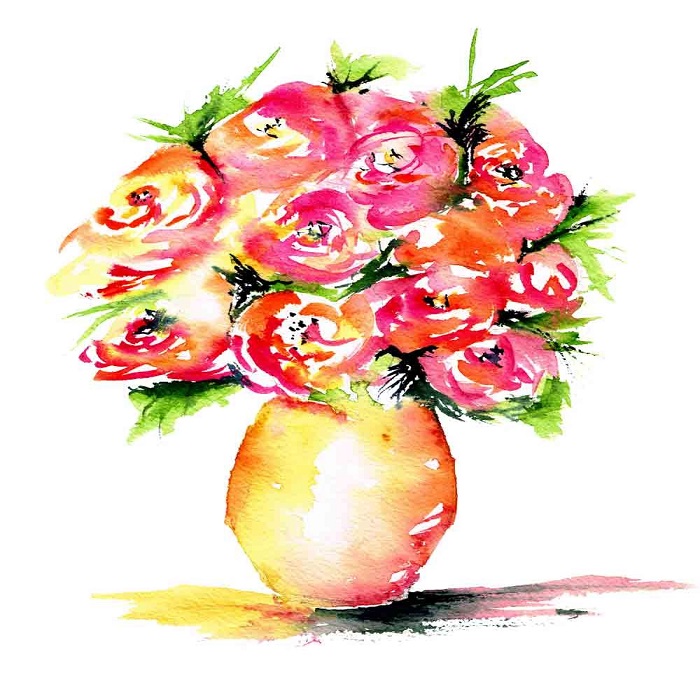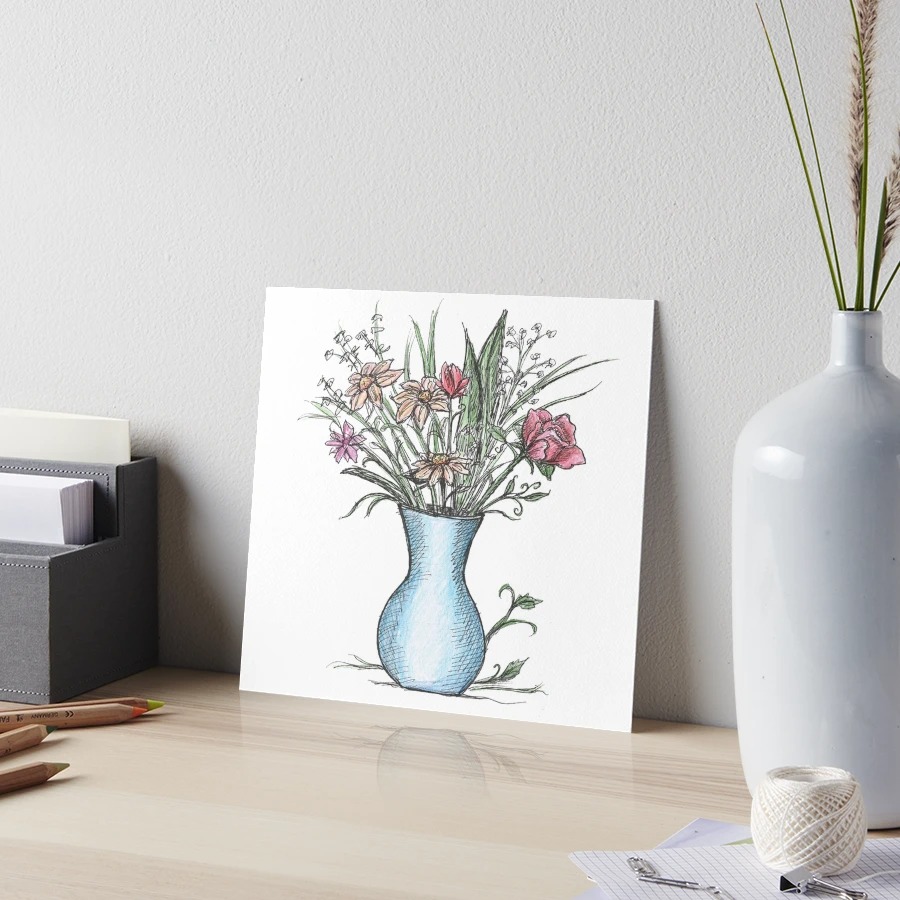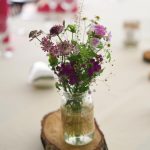Essential Materials for Starting Your Flower Vase Drawing
Before we dive into the process of creating a beautiful flower vase drawing, it’s important to gather all the essential materials. Here’s what you’ll need:
- Pencils: A range of pencils from hard (H) to soft (B) is ideal. Start with a 2H for light sketching and outlines, and a 6B for darker shades.
- Erasers: A kneaded eraser is flexible and perfect for lifting out pencil for highlights or correcting mistakes. A regular eraser is also good to have on hand.
- Paper: High-quality drawing paper with a bit of texture is best. It will hold the graphite well and help with shading.
- Sharpener: Keep your pencils sharp. A manual or electric sharpener will both work fine.
- Drawing Board: A drawing board provides a sturdy surface and can be propped at an angle to help with perspective drawing.
- Ruler: For straight lines and measurements, a clear ruler can assist with symmetry and proportions.
- Blending Tools: Stumps or tortillons, as well as tissue paper or a soft cloth, can be used for blending pencil to smooth out your shading.
Make sure you have a comfortable workspace with good lighting. Natural light is best for viewing true colors and understanding shading. Now that you have all your tools ready, you’re set to start your flower vase drawing journey. Remember, quality materials can make the process smoother and the outcome more professional.
Basic Steps to Sketch a Flower Vase

Begin your flower vase drawing with a light outline. A simple, oval shape for the vase’s opening will start you off. Draw two lines down from the sides of the oval. These lines form the edges of your vase. Keep the curves gentle. Remember, this is just a basic outline. Gradually outline the base of the vase. Vases tend to have a flat bottom for stability. Make sure your vase sits right on your drawing surface. Erase any extra lines that you don’t need. Now refine the outline of your vase. Smooth out any bumps or irregularities in the shape.
Sketch lightly at the beginning. This makes correcting mistakes easier. Your 2H pencil is perfect for this initial stage. Take your time with this part. Patience now will pay off in the later stages of your flower vase drawing. Once you are happy with the vase’s shape, reinforce the lines. Use a darker pencil, like a 6B, for this. But be careful not to press too hard yet. You’ll add more details and shading later. Keep checking your vase from different angles. Symmetry is crucial for a realistic-looking vase.
Remember: your vase doesn’t have to be perfect. Each flower vase has its own charm and character. With these basic steps, you’ve set a strong foundation for a beautiful drawing. As you gain confidence, you can tackle more complex vase shapes and designs.
Understanding Proportions and Perspectives in Vase Drawing
When you’re sketching a flower vase drawing, getting the proportions and perspectives right is key. It turns your simple sketches into realistic, three-dimensional art. Here’s how to master these concepts.
Start by deciding on the height and width of your vase. Use your ruler to compare parts of the vase to each other. The opening should be in proportion to the base. If your vase narrows in the middle, note how much narrower it is compared to the top and bottom.
Next, observe the perspective. Most vases aren’t perfectly straight. They curve and change shape. View your vase from different angles. Notice how the curves create an illusion of depth. This is what you need to capture in your drawing.
For symmetry, compare both sides of the vase. They should mirror each other. Use the center line of your vase as a guide. It helps to keep the sides balanced. If your vase has patterns or designs, they need to follow the vase’s shape and perspective too.
Remember, in drawing, what looks right is often more important than perfect measurements. Trust your eye. If something looks off, adjust it even if it measures correctly.
Always step back and view your work from a distance. It will help you see the overall shape and balance. With practice, understanding proportions and perspectives comes naturally. And your flower vase drawings will look more convincing and polished as a result.
Adding Details: Drawing the Flowers
Once you have sketched your vase to satisfaction, it’s time to add the details. Drawing flowers within the vase brings your composition to life. There are a few key steps to ensure that your flower vase drawing comes out looking vibrant and full of character.
- Sketch the Basic Shapes: Begin by sketching the general form of each flower. Circles and ovals can represent the overall shape of blooms. Look for the basic shapes in the petals and leaves.
- Define Petal Structure: After the basic shapes, add lines to suggest petals. Start from the center and work outwards. Pay attention to how the petals overlap and the direction in which they grow.
- Include Variety: Different types of flowers and leaves add interest. Play with sizes, lengths, and shapes to create a dynamic arrangement.
- Consider Composition: Balance your drawing by placing larger blooms towards the center or bottom of the vase. Let smaller flowers fill in the gaps and create a sense of abundance.
- Be Mindful of Perspective: Flowers further away will appear smaller and less detailed. Use this to give your drawing depth.
- Draw Stems and Foliage: Connect the flowers with stems to the base of the vase. Add leaves in spaces between flowers to create fullness.
For every flower and leaf, use light, fluid strokes to maintain a natural look. If you make an error, simply use your eraser to adjust the shape. With each added detail, your flower vase drawing will become more captivating and realistic. Remember, the arrangement of flowers is a chance to express creativity, so feel free to experiment with your design.
Shading Techniques to Bring Your Drawing to Life

Shading is vital in giving your flower vase drawing depth and dimension. Here’s how to shade effectively.
- Start with Light Layers: Use a light pencil, such as 2H, to begin shading. Build up the tone gradually.
- Consider Light Direction: Choose a light source direction. Shade the opposite side of your vase darker to create a shadow effect.
- Enhance Curves: Shade along the vase’s curves. This adds roundness and makes it look three-dimensional.
- Deepen Shadows: Use a softer pencil, like a 6B, for deeper shadows. Areas behind flowers and under the vase need darker shading.
- Blend for Smoothness: Use blending tools like stumps or a piece of tissue. This smooths the pencil strokes for a more realistic look.
- Highlight for Impact: Use an eraser to lift graphite off the vase’s brightest spots. This brings out highlights and adds realism.
Keep your strokes consistent and control pressure on your pencils. Shading takes practice, so be patient and keep refining your technique. Your flower vase drawing will start to pop off the page with these shading methods.
Tips for a Realistic Flower Arrangement in Your Vase
To make your flower vase drawing look lifelike, consider these easy-to-follow tips:
- Work From Life or Photos: Use a real flower arrangement or a photo as a reference. This helps with accuracy in shapes and proportions.
- Vary the Flower Sizes: Mix large and small flowers. It prevents monotony and adds interest to your drawing.
- Think About Depth: Place some flowers in the foreground and others in the background. This creates a 3D effect.
- Play with Textures: Draw different petal textures. Some can be smooth, others ruffled or pointed. It adds variety to your floral display.
- Use Eraser for Highlights: To make petals stand out, use your eraser to bring in highlights. This helps define the petal edges.
- Include Shadows Between Flowers: Show where flowers overlap by shading. It gives depth and realism to your arrangement.
- Add Drops of Water: For a fresh look, draw small ovals to represent water drops on petals or leaves.
- Stick to a Theme: Decide on a color scheme or type of flower. It keeps the arrangement cohesive.
Creating a realistic flower arrangement takes patience and practice. Keep experimenting with placement and shading. In time, your flower vase drawings will bloom with life and realism.
Creative Ideas to Personalize Your Flower Vase Drawings
After mastering the basics of flower vase drawing, you can start adding personal touches to make your artwork stand out. These creative ideas will help your flower vase drawings reflect your unique style and imagination.
- Experiment with Textures: Add variety by using different textures in your pencil strokes. This could mimic the roughness of a terracotta vase or the smoothness of a glass one.
- Incorporate Patterns: Consider sketching geometric patterns or floral designs on the vase surface. Use a light touch for subtle patterns or go bold for a dramatic effect.
- Play with Color: If you’re comfortable, introduce colored pencils or watercolors. Colors can bring a new dimension to your drawings.
- Change the Vase Shape: Don’t be afraid to alter traditional vase shapes. Try drawing tall, slender vases, wide bowls, or even abstract shapes.
- Add Background Elements: Put your vase on a window sill, include a table, or sketch a garden in the background. This sets the scene for your flower arrangement.
- Personalize with Accessories: Draw ribbons, lace, or even jewelry draped around the vase. This can add a touch of elegance or whimsy.
- Mix Realism with Abstract: Blend realistic flowers with abstract patterns around or within the vase. This creates a captivating contrast in your drawing.
- Use Shadows Creatively: Be inventive with shadows to set a mood or time of day. Soft, light shadows can suggest morning, while long, dark ones might evoke evening.
Keep playing with different elements and see how they change the story of your flower vase drawing. With each change, your personal style will shine through more brightly. And remember: the most important thing is to have fun and enjoy the creative process!
Finishing Touches: How to Clean Up and Refine Your Drawing

Once you’ve added detail and shading to your flower vase drawing, it’s time for the finishing touches. These final steps can truly make your artwork shine and look polished.
- Evaluate the Overall Composition: Step back and review your drawing. Look for balance and harmony in the arrangement.
- Refine Lines and Shapes: Tighten any loose lines. Smooth out shapes where necessary, keeping the feel organic.
- Adjust Contrast and Depth: Enhance deeper shadows or soften areas that are too dark. Aim for a balanced contrast.
- Clean Up Smudges: Use a kneaded eraser to gently lift any pencil smudges from the paper. Keeping it clean adds to the drawing’s professionalism.
- Finalize Highlights: Add any last-minute highlights with your eraser for a touch of dimension, especially on the vase’s curves and edges.
- Check Details: Ensure that smaller elements like petal textures and water drops are distinct and clear.
- Sign Your Work: Put your signature on the drawing. It marks your creation and shows ownership.
Remember, refining your flower vase drawing is about enhancing what you’ve already sketched. Be gentle with your adjustments, and let your creativity guide you. With each drawing, you’ll find your process of refinement becoming more intuitive. Keep practicing, and you will consistently create beautiful, lifelike flower vase drawings.

